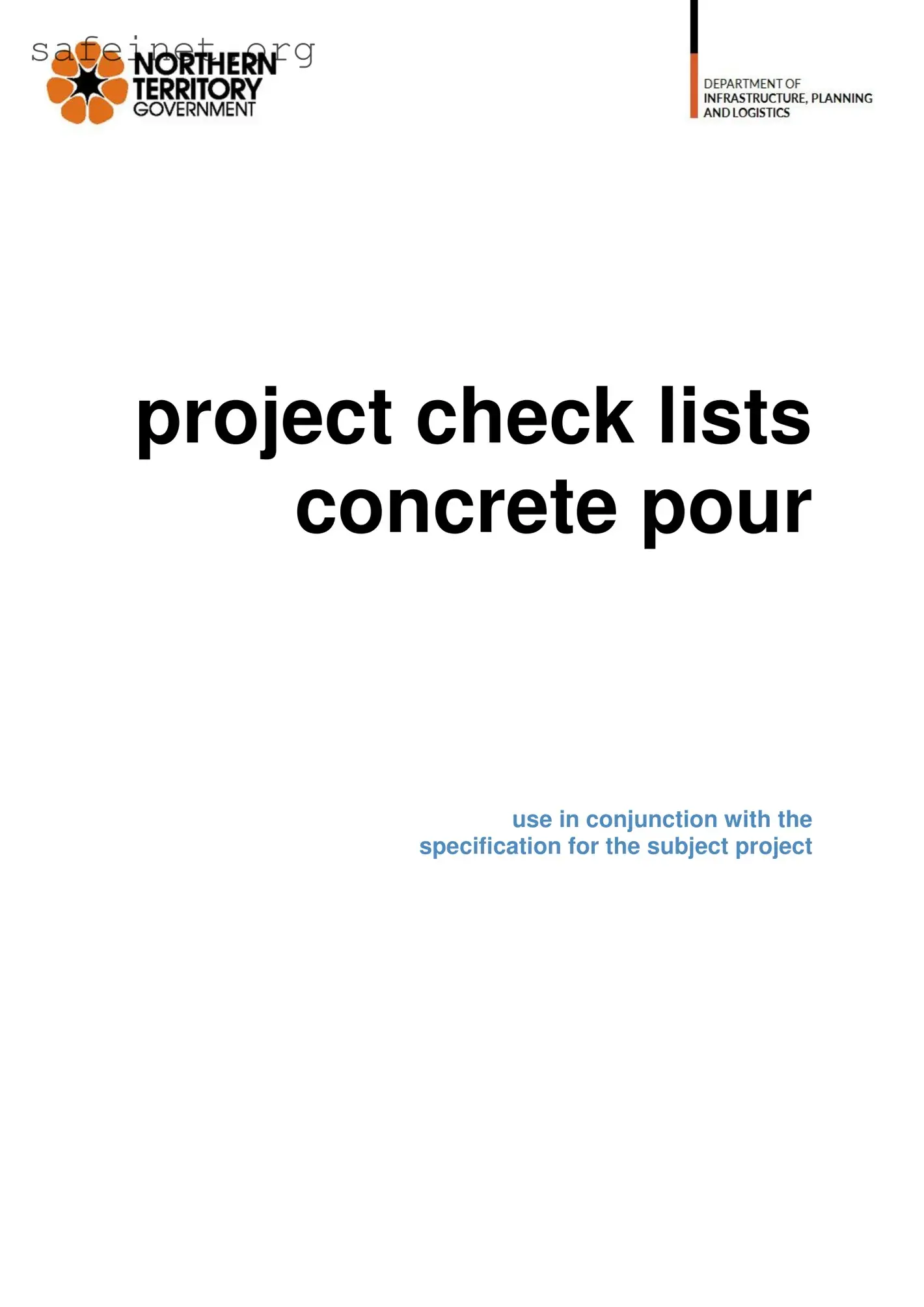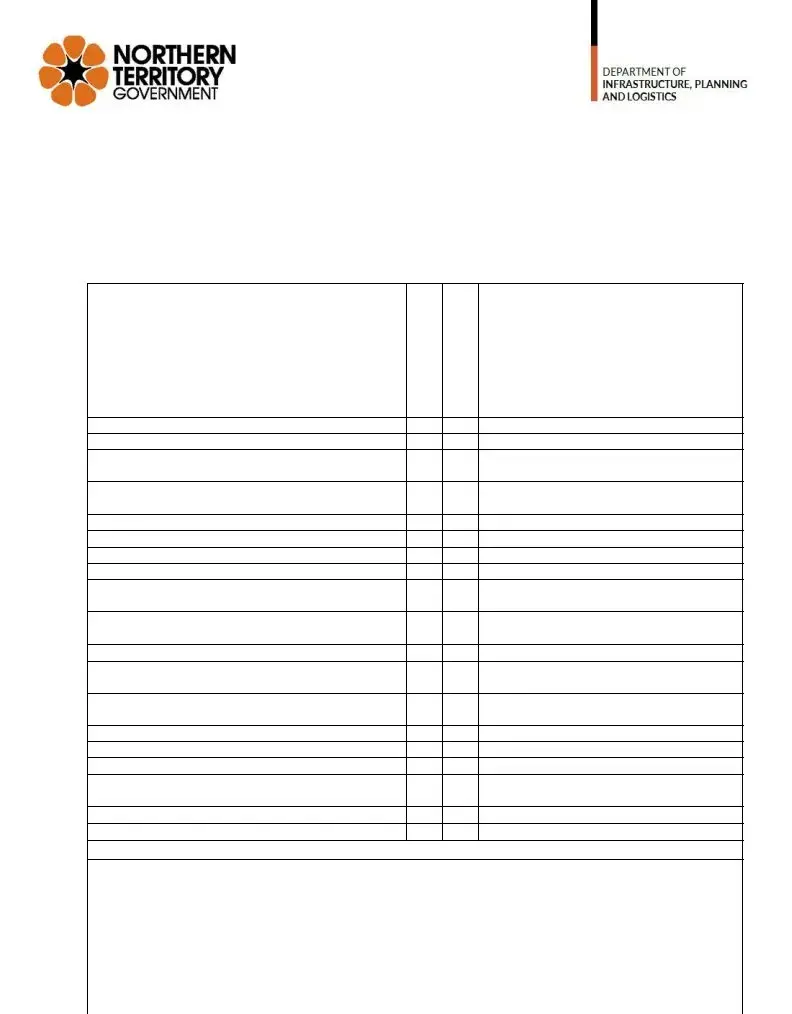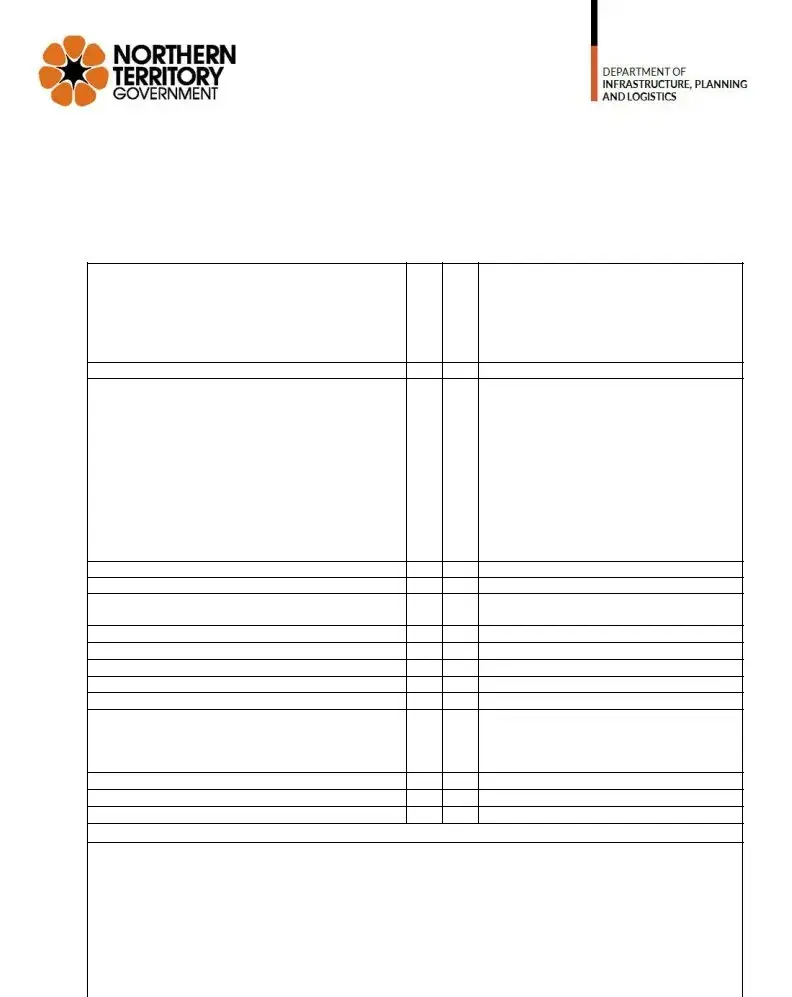project check lists concrete pour
use in conjunction with the specification for the subject project
INTRODUCTION
It is difficult during a visit to a construction site to memorise all of the details that need to be checked and while the obvious ones stand out, many other items that should be checked are forgotten. Supervisors may get distracted or over extended due to time constraints and overlook items that may have more serious consequences later in the project.
These Check Lists provide a guide to the inspections that are required on site for a particular project. They are a précis of the full clauses in the project specification and can be referred back to the specification if the full text of the particular item is required. The Check Lists will remind you of virtually every potential problem in materials, workmanship and coordination between trades.
The Check Lists include a list of the Hold Points, Witness Points and Tests that are required to be signed off by the Supervisor on projects that include the Project Control section. The rest of the checks are simply dot points to jog the memory of the Supervisor.
Project specific checks may be added to the Check Lists for individual projects and the experience of Supervisors can be shared by the addition of particular checks on items or operations that are generally of concern on site. In this case less experienced Supervisors can use these Check Lists to provide them with the back up of more experienced officers.
Provide one copy of the Check Lists book to the Supervisor and one copy to the Contractor for the particular project.
HOW TO USE THESE CHECK LISTS
Take photocopies of the relevant Check List sections before going on site and study these. This book of Check Lists is spiral bound to allow pages to be photocopied easily.
Mark any items in the Check List that are of particular concern.
At the project site, check off the work against the Check Lists and make notes of any action required in the space provided.
When the work is completed and the final check has been made sign off and date in the box provided. There is also space to provide comments.
Keep a record of all of the completed Check Lists for future reference if required. These could prove to be valuable if disputes arise on the project.
There is no better way to document actual site conditions or details than by photographs, so don’t forget to take a digital camera on site and take images to go with particular items in the Check lists.
FURTHER DEVELOPMENT
If you have any suggestions to improve on these Check Lists or the system in general please contact Lawrie Foscaro, Manager, Specification Services, 3rd Floor Highway House, Palmerston. Tel; 8946 5021 or email [email protected].
Doc ID |
Version |
Issued |
Printed |
Page |
1.04–PCL CONCRETE POUR |
2016.03 |
Sept 2016 |
19/09/2016 |
2 of 4 |
Comments from in-house staff, consultants or contractors are most welcome.
CONCRETE POUR CHECKLIST
Project/Job Name:
Contract No:
Audit Date:
Contractor:
Concrete Supplier:
Mix Design Approved/Not Approved
|
Audit Item |
Y |
N |
Comments |
|
1. Preliminary |
|
|
|
• |
Description |
|
|
|
• |
Lot Number/s |
|
|
|
• |
Previous Lots Conform |
|
|
|
• |
Casting Program Accepted |
|
|
|
|
|
|
|
|
• |
Curing Method |
|
|
|
|
(Stream) (Water) (Fog) (Other) |
|
|
|
2. Formwork and Falsework
• Formwork Dimensions in Accordance with Design, including void lengths
• Forms Clean, Smooth and Watertight and Free
of Deleterious/Extraneous/Foreign Materials
• Formwork within Dimension Tolerances
• Forms Meet Line and Level Requirements
3. Reinforcing Steel
• Steel Located/Fixed in Accordance with Drawings
• Reinforcing Clean and Free of Deleterious
Materials
• Critical Cover of 30mm Checked at all locations
• All Splices to Reinforcement at Approved Locations
• All Welds in Accordance with Australian Standards and RFT
4. Concrete Inclusions
• Embedded Dowels, Bolts, Conduits and Ducts
• Cored Holes, Weepholes, Block Outs, transverse stressing holes
• Lifting/Carrying Lugs etc
• Located as Shown on Drawings
Audit Results and Comments
Signature: |
|
|
Date |
|
|
|
|
|
|
|
|
|
|
|
|
|
|
|
|
|
Doc ID |
Version |
|
Issued |
Printed |
Page |
|
1.04–PCL CONCRETE POUR |
2016.03 |
Sept 2016 |
19/09/2016 |
3 of 4 |
|
|
Audit Item |
Y |
N |
Comments |
|
|
5. Concrete Delivery |
|
|
|
|
• |
Number of Batches |
|
|
|
|
• Batch Time (From Delivery Docket) |
|
1. |
2. |
3. |
• Arrival Time at Site |
|
1. |
2. |
3. |
• |
Finish Time |
|
1. |
2. |
3. |
|
6. Concrete Testing |
|
|
|
• |
NATA Approved Testing Authority |
Name: |
|
|
• Ambient Temperature (Between 5oC and 35oC) |
|
|
|
• |
Actual Concrete Temperature |
1. |
2. |
3. |
• |
Target Slump 50 mm ± 10mm. Actual Slump |
1. |
|
|
|
|
2. |
|
|
|
|
3. |
|
|
• |
Amount of Admixture added |
1. |
2. |
3. |
• |
Amount of water added |
1. |
2. |
3. |
• Number of Cylinders Taken |
|
|
|
• |
Target Strength |
|
|
|
7. Concrete Placement
• Placement Method (Pump, Tremie, Chute,
Other)
• Sufficient Personnel for Finishing etc.
• Approved Vibration Method
• Back up Vibrators on Hand
• Reinforcement Cover Maintained During Pour
• Formwork Stable During Placing and Vibration
• Concrete Placed and Compacted Within: 25oC – 28oC = 75mins
28oC – 32oC = 60 mins 32oC – 35oC = 45 mins
• Provision for Closure of Access/Openings
• Forms Free of Foreign Matter Prior to Pouring
• Concrete Finished to Approved Tolerances
Audit Results and Comments
Signature: |
|
|
Date |
|
|
|
|
|
|
|
|
|
|
|
|
|
|
|
|
|
Doc ID |
Version |
|
Issued |
Printed |
Page |
|
1.04–PCL CONCRETE POUR |
2016.03 |
Sept 2016 |
19/09/2016 |
4 of 4 |
|




